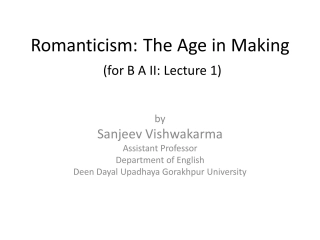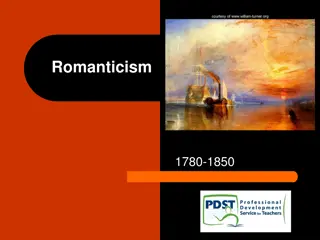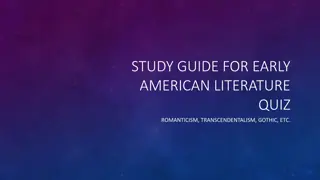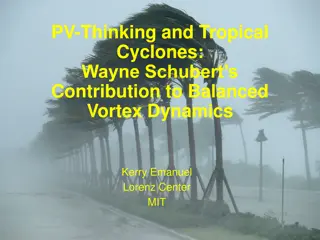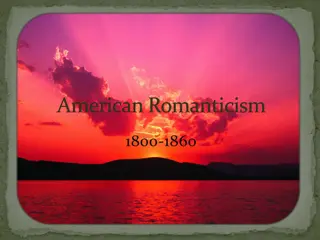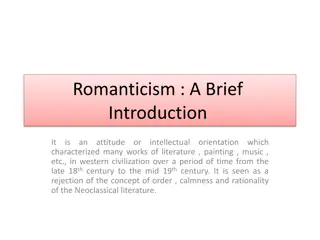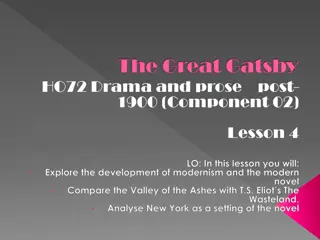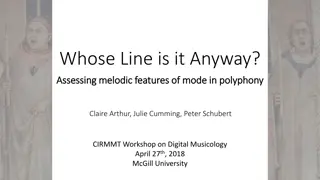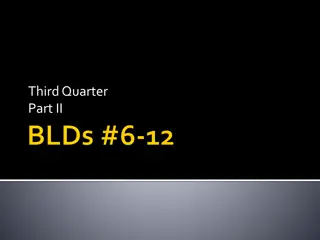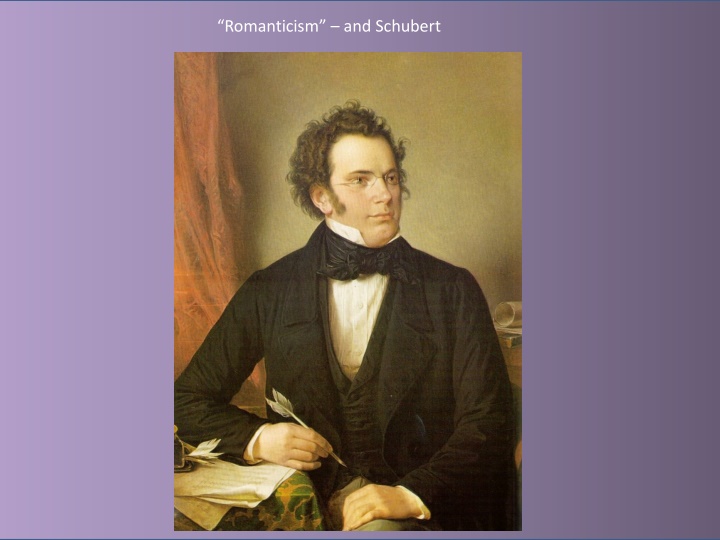
Romanticism in Music Through Schubert's Symphony No. 8
Explore the essence of Romanticism in music as depicted through Schubert's Symphony No. 8. Delve into the theme of individual subjectivity, inwardness, and aestheticism that characterized this era, offering a refuge from politics and a pathway to altered consciousness.
Uploaded on | 1 Views
Download Presentation

Please find below an Image/Link to download the presentation.
The content on the website is provided AS IS for your information and personal use only. It may not be sold, licensed, or shared on other websites without obtaining consent from the author. If you encounter any issues during the download, it is possible that the publisher has removed the file from their server.
You are allowed to download the files provided on this website for personal or commercial use, subject to the condition that they are used lawfully. All files are the property of their respective owners.
The content on the website is provided AS IS for your information and personal use only. It may not be sold, licensed, or shared on other websites without obtaining consent from the author.
E N D
Presentation Transcript
What is Romanticism in Music? Taruskin, vol. III, ch. 2 The reliance on individual subjectivity as truth (62) (71) The I : Inwardness, interiority: Innigkeit, Innerlichkeit(63): the public display of privacy 63); private music allowed to be overheard (63) Refuge in aestheticism as a bearer of truth, estranged from politics (62)
What is Romanticism in Music? Taruskin, vol. III, ch. 2 The reliance on individual subjectivity as truth (62) (71) The I : Inwardness, interiority: Innigkeit, Innerlichkeit(63): the public display of privacy 63); private music allowed to be overheard (63) Refuge in aestheticism as a bearer of truth, estranged from politics (62) The music trance (title of Ch. 2); trances or personal reveries as proper artistic responses for the listener (71) Music as trance-induction (73) i.e., fusing oneself totally with the tone and processes of the music; total absorption; becoming one with the music Altered consciousness (69); stepping out of real time and the real world into a more purely subjective world
What is Romanticism in Music? Taruskin, vol. III, ch. 2 The reliance on individual subjectivity as truth (62) (71) The I : Inwardness, interiority: Innigkeit, Innerlichkeit(63): the public display of privacy 63); private music allowed to be overheard (63) Refuge in aestheticism as a bearer of truth, estranged from politics (62) The music trance (title of Ch. 2); trances or personal reveries as proper artistic responses for the listener (71) Music as trance-induction (73) i.e., fusing oneself totally with the tone and processes of the music; total absorption; becoming one with the music Altered consciousness (69); stepping out of real time and the real world into a more purely subjective world Schubert, opening of Symphony No. 8 in B Minor ( Unfinished, 1822)
What Is Romanticism More Generally? The subjective restlessness of a new, aesthetic generation unsettled by the demystifying, secular-rational thrust of modernizing times
What Is Romanticism More Generally? The subjective restlessness of a new, aesthetic generation unsettled by the demystifying, secular-rational thrust of modernizing times, e.g., Enlightenment thought, questioning the metaphysical and spiritual, placing limits on philosophical reflection and personal experience.
What Is Romanticism More Generally? The subjective restlessness of a new, aesthetic generation unsettled by the demystifying, secular-rational thrust of modernizing times, e.g., Enlightenment thought, questioning the metaphysical and spiritual, placing limits on philosophical reflection and personal experience. The growing impact of science and technology ( industrial revolution ) merged with everyday urban-economic and legal practice: practical concerns and claims that likewise rendered the spiritual increasingly irrelevant.
What Is Romanticism More Generally? The subjective restlessness of a new, aesthetic generation unsettled by the demystifying, secular-rational thrust of modernizing times, e.g., Enlightenment thought, questioning the metaphysical and spiritual, placing limits on philosophical reflection and personal experience. The growing impact of science and technology ( industrial revolution ) merged with everyday urban-economic and legal practice: practical concerns and claims that likewise rendered the spiritual increasingly irrelevant. Thus: a search within art, poetry, music, to reinflate the collapsing (collapsed?) canopy of the spirit, the metaphysical claiming through art and emotion to reach beyond the limits of normative experience.
What Is Romanticism More Generally? The subjective restlessness of a new, aesthetic generation unsettled by the demystifying, secular-rational thrust of modernizing times, e.g., Enlightenment thought, questioning the metaphysical and spiritual, placing limits on philosophical reflection and personal experience. The growing impact of science and technology ( industrial revolution ) merged with everyday urban-economic and legal practice: practical concerns and claims that likewise rendered the spiritual increasingly irrelevant. Thus: a search within art, poetry, music, to reinflate the collapsing (collapsed?) canopy of the spirit, the metaphysical claiming through art and emotion to reach beyond the limits of normative experience. From this perspective: Germanic Romanticism (along with Romantic nationalism) is a counter-Enlightenment movement.
What Is Romanticism in Music? An intricate, internally networked system of new-generational belief:
What Is Romanticism in Music? An intricate, internally networked system of new-generational belief: A complex dogmatics of faith (faith in music/art), originating in limited circles in Austria (Vienna) and Germany
What Is Romanticism in Music? An intricate, internally networked system of new-generational belief: A complex dogmatics of faith (faith in music/art), originating in limited circles in Austria (Vienna) and Germany Central tenet: music as a subjectively devotional practice, in pursuit of deeper, truer experiences a better, alternative world
What Is Romanticism in Music? An intricate, internally networked system of new-generational belief: A complex dogmatics of faith (faith in music/art), originating in limited circles in Austria (Vienna) and Germany Central tenet: music as a subjectively devotional practice, in pursuit of deeper, truer experiences a better, alternative world Thus: The Ongoing Romantic Project
What Is Romanticism in Music? An intricate, internally networked system of new-generational belief: A complex dogmatics of faith (faith in music/art), originating in limited circles in Austria (Vienna) and Germany Central tenet: music as a subjectively devotional practice, in pursuit of deeper, truer experiences a better, alternative world Thus: The Ongoing Romantic Project And thus: a new-generational view of music as Art (capital-A) grounded in a spiritualized or metaphysical core; insight; authenticity; disclosure; revelation; truth
What Is Romanticism in Music? An intricate, internally networked system of new-generational belief: A complex dogmatics of faith (faith in music/art), originating in limited circles in Austria (Vienna) and Germany Central tenet: music as a subjectively devotional practice, in pursuit of deeper, truer experiences a better, alternative world Thus: The Ongoing Romantic Project And thus: a new-generational view of music as Art (capital-A) grounded in a spiritualized or metaphysical core; insight; authenticity; disclosure; revelation; truth Schubert, Piano Sonata in A, D. 664 (1819)
The Enlightenment world, or the rational world of cognition and normative interaction. Here there are limits, borders to our knowledge to that knowledge only accessible by reason or everyday reflection and action, etc. Trapped? No escape beyond?
? ? The Enlightenment world, or the rational world of cognition and normative interaction. Here there are limits, borders to our knowledge to that knowledge only accessible by reason or everyday reflection and action, etc. Trapped? No escape beyond? ? ?
The External Sublime Instrumental music as a conduit, a quasi-sacred mystery; a purifier; a discloser of truth; beyond the limits Interiority; The Pre-Cognitive Soul
The External Sublime Instrumental music as a conduit, a quasi-sacred mystery; a purifier; a discloser of truth; beyond the limits Interiority; The Pre-Cognitive Soul Schubert, Impromptu in G-flat, D. 899 (1827)
An aesthetics of absorption; the music trance, immune from rational critique: Schubert, Impromptu in G-flat, D. 899 (1827) Moritz von Schwind, Drawing, 1868: A Schubert-Evening at the Home of Joseph von Spaun [a Schubertiade ]
An aesthetics of absorption; the music trance, immune from rational critique: Schubert: String Quintet in C, D. 956 (1828), Adagio Moritz von Schwind, Drawing, 1868: A Schubert-Evening at the Home of Joseph von Spaun [a Schubertiade ]
An aesthetics of absorption; the music trance, immune from rational critique: Schubert: String Quintet in C, D. 956 (1828), Adagio Composer Performer/Listener Moritz von Schwind, Drawing, 1868: A Schubert-Evening at the Home of Joseph von Spaun [a Schubertiade ]
Romanticism in Music [JH] An intricate, internally networked system of new-generational belief, a complex dogmatics of faith (faith in music/art). Music as a subjectively devotional practice, in pursuit of deeper, truer experiences. Music as Art (capital-A), with a spiritualized or metaphysical core; insight; authenticity; disclosure; revelation; truth.
Romanticism in Music [JH] An intricate, internally networked system of new-generational belief, a complex dogmatics of faith (faith in music/art). Music as a subjectively devotional practice, in pursuit of deeper, truer experiences. Music as Art (capital-A), with a spiritualized or metaphysical core; insight; authenticity; disclosure; revelation; truth. What are the obligations for members of the faithful?
Romanticism in Music [JH] An intricate, internally networked system of new-generational belief, a complex dogmatics of faith (faith in music/art). Music as a subjectively devotional practice, in pursuit of deeper, truer experiences. Music as Art (capital-A), with a spiritualized or metaphysical core; insight; authenticity; disclosure; revelation; truth. What are the obligations for members of the faithful? 1. To pursue the aesthetic cultivation of the self (a personal regimen of Bildung)
Romanticism in Music [JH] An intricate, internally networked system of new-generational belief, a complex dogmatics of faith (faith in music/art). Music as a subjectively devotional practice, in pursuit of deeper, truer experiences. Music as Art (capital-A), with a spiritualized or metaphysical core; insight; authenticity; disclosure; revelation; truth. What are the obligations for members of the faithful? 1. To pursue the aesthetic cultivation of the self (a personal regimen of Bildung) Embrace and cultivate the highest and best
Romanticism in Music [JH] An intricate, internally networked system of new-generational belief, a complex dogmatics of faith (faith in music/art). Music as a subjectively devotional practice, in pursuit of deeper, truer experiences. Music as Art (capital-A), with a spiritualized or metaphysical core; insight; authenticity; disclosure; revelation; truth. What are the obligations for members of the faithful? 1. To pursue the aesthetic cultivation of the self (a personal regimen of Bildung) Embrace and cultivate the highest and best Reject and flee Kitsch: the second-rate, the tawdry, the imitative, the commercial
Schubert, Piano Sonata in A, D. 664 (1819) Moritz von Schwind, Drawing, 1868: A Schubert-Evening at the Home of Joseph von Spaun [a Schubertiade ]
Romanticism in Music [JH] An intricate, internally networked system of new-generational belief, a complex dogmatics of faith (faith in music/art). Music as a subjectively devotional practice, in pursuit of deeper, truer experiences. Music as Art (capital-A), with a spiritualized or metaphysical core; insight; authenticity; disclosure; revelation; truth. What are the obligations for members of the faithful? 1. To pursue the aesthetic cultivation of the self (a personal regimen of Bildung) Embrace and cultivate the highest and best Reject and flee Kitsch: the second-rate, the tawdry, the imitative, the commercial 2. To understand the romantic/aesthetic program as culture-critical, unwilling to merge into dominant culture (shallow, deceived, false consciousness )
Romanticism in Music [JH] An intricate, internally networked system of new-generational belief, a complex dogmatics of faith (faith in music/art). Music as a subjectively devotional practice, in pursuit of deeper, truer experiences. Music as Art (capital-A), with a spiritualized or metaphysical core; insight; authenticity; disclosure; revelation; truth. What are the obligations for members of the faithful? 1. To pursue the aesthetic cultivation of the self (a personal regimen of Bildung) Embrace and cultivate the highest and best Reject and flee Kitsch: the second-rate, the tawdry, the imitative, the commercial 2. To understand the romantic/aesthetic program as culture-critical, unwilling to merge into dominant culture (shallow, deceived, false consciousness ) Thus: the artist viewed as eternal outsider
Romanticism in Music [JH] An intricate, internally networked system of new-generational belief, a complex dogmatics of faith (faith in music/art). Music as a subjectively devotional practice, in pursuit of deeper, truer experiences. Music as Art (capital-A), with a spiritualized or metaphysical core; insight; authenticity; disclosure; revelation; truth. What are the obligations for members of the faithful? 1. To pursue the aesthetic cultivation of the self (a personal regimen of Bildung) Embrace and cultivate the highest and best Reject and flee Kitsch: the second-rate, the tawdry, the imitative, the commercial 2. To understand the romantic/aesthetic program as culture-critical, unwilling to merge into dominant culture (shallow, deceived, false consciousness ) Thus: the artist viewed as eternal outsider Escape, then, into the truer world of music/art
Division of the Experiential Totality into Two Non-Intersecting Worlds
Division of the Experiential Totality into Two Non-Intersecting Worlds Everyday World
Division of the Experiential Totality into Two Non-Intersecting Worlds Everyday World Enlightenment, secular rationality
Division of the Experiential Totality into Two Non-Intersecting Worlds Everyday World Enlightenment, secular rationality Emerging world of commerce, industry, the marketplace, the ordinary
Division of the Experiential Totality into Two Non-Intersecting Worlds Everyday World Enlightenment, secular rationality Emerging world of commerce, industry, the marketplace, the ordinary Hemmed in by the natural limits of reason
Division of the Experiential Totality into Two Non-Intersecting Worlds Everyday World Enlightenment, secular rationality Emerging world of commerce, industry, the marketplace, the ordinary Hemmed in by the natural limits of reason Non-emancipatory (non-redemptive), as in shallow, commonplace life:
Division of the Experiential Totality into Two Non-Intersecting Worlds Everyday World Enlightenment, secular rationality Emerging world of commerce, industry, the marketplace, the ordinary Hemmed in by the natural limits of reason Non-emancipatory (non-redemptive), as in shallow, commonplace life: Business transactions
Division of the Experiential Totality into Two Non-Intersecting Worlds Everyday World Enlightenment, secular rationality Emerging world of commerce, industry, the marketplace, the ordinary Hemmed in by the natural limits of reason Non-emancipatory (non-redemptive), as in shallow, commonplace life: Business transactions Objective scientific inquiry & analysis
Division of the Experiential Totality into Two Non-Intersecting Worlds Everyday World Enlightenment, secular rationality Emerging world of commerce, industry, the marketplace, the ordinary Hemmed in by the natural limits of reason Non-emancipatory (non-redemptive), as in shallow, commonplace life: Business transactions Objective scientific inquiry & analysis Practical functioning of government
Division of the Experiential Totality into Two Non-Intersecting Worlds Everyday World Enlightenment, secular rationality Emerging world of commerce, industry, the marketplace, the ordinary Hemmed in by the natural limits of reason Non-emancipatory (non-redemptive), as in shallow, commonplace life: Business transactions Objective scientific inquiry & analysis Practical functioning of government Commercialized art/Kitsch
Division of the Experiential Totality into Two Non-Intersecting Worlds Everyday World Enlightenment, secular rationality Emerging world of commerce, industry, the marketplace, the ordinary Hemmed in by the natural limits of reason Non-emancipatory (non-redemptive), as in shallow, commonplace life: Business transactions Objective scientific inquiry & analysis Practical functioning of government Commercialized art/Kitsch Methodical systems of explanation (including systems analyzing art)
Division of the Experiential Totality into Two Non-Intersecting Worlds Everyday World Enlightenment, secular rationality Emerging world of commerce, industry, the marketplace, the ordinary Hemmed in by the natural limits of reason Non-emancipatory (non-redemptive), as in shallow, commonplace life: Business transactions Objective scientific inquiry & analysis Practical functioning of government Commercialized art/Kitsch Methodical systems of explanation (including systems analyzing art) Indifference to the spiritual
Division of the Experiential Totality into Two Non-Intersecting Worlds Everyday World Enlightenment, secular rationality Emerging world of commerce, industry, the marketplace, the ordinary Hemmed in by the natural limits of reason Non-emancipatory (non-redemptive), as in shallow, commonplace life: Business transactions Objective scientific inquiry & analysis Practical functioning of government Commercialized art/Kitsch Methodical systems of explanation (including systems analyzing art) Indifference to the spiritual Public opinion
Division of the Experiential Totality into Two Non-Intersecting Worlds Everyday World Enlightenment, secular rationality Emerging world of commerce, industry, the marketplace, the ordinary Hemmed in by the natural limits of reason Non-emancipatory (non-redemptive), as in shallow, commonplace life: Business transactions Objective scientific inquiry & analysis Practical functioning of government Commercialized art/Kitsch Methodical systems of explanation (including systems analyzing art) Indifference to the spiritual Public opinion Blind acceptance of tradition
Division of the Experiential Totality into Two Non-Intersecting Worlds Everyday World Enlightenment, secular rationality Emerging world of commerce, industry, the marketplace, the ordinary Hemmed in by the natural limits of reason Non-emancipatory (non-redemptive), as in shallow, commonplace life: Business transactions Objective scientific inquiry & analysis Practical functioning of government Commercialized art/Kitsch Methodical systems of explanation (including systems analyzing art) Indifference to the spiritual Public opinion Blind acceptance of tradition Etc.
Division of the Experiential Totality into Two Non-Intersecting Worlds Everyday World Enlightenment, secular rationality Emerging world of commerce, industry, the marketplace, the ordinary Hemmed in by the natural limits of reason Non-emancipatory (non-redemptive), as in shallow, commonplace life: Business transactions Objective scientific inquiry & analysis Practical functioning of government Commercialized art/Kitsch Methodical systems of explanation (including systems analyzing art) Indifference to the spiritual Public opinion Blind acceptance of tradition Etc.

